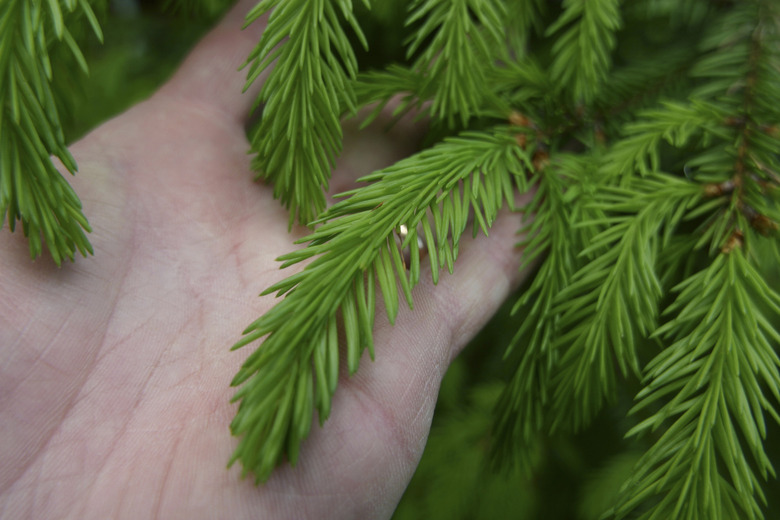Transplant Problems In A Dwarf Alberta Spruce
As a busy mom, if you decide that a dwarf Alberta spruce (Picea glauca "Conica") is in the wrong place and transplant it to a new spot, the last thing you need is to worry about whether it'll survive the move. Knowing the signs of trouble can help you avoid problems that could lead to loss of the transplanted shrub. If your kids are old enough, they can pitch in and help with the move itself, and also give the plant extra care in its new spot to help it do well and avoid problems. The dwarf Alberta spruce is a versatile, slow-growing evergreen that works well in many locations and thrives in U.S. Department of Agriculture plant hardiness zones 3 through 6.
Problems To Avoid
Step 1
A dwarf Alberta spruce that's been recently transplanted might have a difficult time absorbing water from the soil, because its roots were damaged during the move. Signs of this type of stress include die-back of small branches or twigs, or loss of needles. Needles might also turn yellowish, a problem called chlorosis that can develop when a plant is starved for nutrients, another sign of poor root function. Brown tips on needles can also indicate a problem, but this is usually minor if needles remain on the plant. These problems usually resolve with time, especially if you exercise care during the transplant process and give the plant good care in its new spot.
- As a busy mom, if you decide that a dwarf Alberta spruce (Picea glauca "Conica") is in the wrong place and transplant it to a new spot, the last thing you need is to worry about whether it'll survive the move.
- These problems usually resolve with time, especially if you exercise care during the transplant process and give the plant good care in its new spot.
It's About Roots
Step 1
If a dwarf Alberta spruce has only been in its current spot for a year or two, transplanting it is relatively easy, because its root ball is still small and manageable. A larger, mature specimen requires extra care to loosen the plant's roots while minimizing root damage. In either case, dig a 1-foot-deep trench around the root area to form the root ball, with the diameter of the trench about 1 foot in diameter for every foot of the shrub's height. So for a plant that's 5 feet tall, the trench would be 5 feet across. With the trench dug, slip a spade under the root ball and lift the plant onto burlap or plastic, cutting any roots that grow straight down with pruners or a sharp knife.
Timing Is Critical
Step 1
Although you can transplant a specimen at any time, it's best to plan the move for the end of the dormant season in late winter or early spring when the plant's beginning to show signs of new life. If this isn't possible, it's best to wait until late summer or early fall, when the plant is still able to put out new roots before winter cold arrives. Water the plant deeply and regularly for several weeks before the move to ensure its roots are healthy. Transplanting a shrub during the hot, dry summer months isn't advisable, because high temperatures put additional stress on the plant.
- If a dwarf Alberta spruce has only been in its current spot for a year or two, transplanting it is relatively easy, because its root ball is still small and manageable.
- If this isn't possible, it's best to wait until late summer or early fall, when the plant is still able to put out new roots before winter cold arrives.
Making the Move
Step 1
Preparing the new planting site correctly can also help avoid transplant problems. Remove weeds and any competing roots from the new spot, and turn the soil over a week or two before the move, adding some compost if your soil's fertility isn't high. Avoid chemical fertilizers, because these can burn new roots. Gently remove the root ball's burlap or plastic covering, and plant the shrub in a hole about twice the size of the root ball, placing it at its original depth, or just a bit higher to allow for settling. Backfill the hole with fine soil, drenching the plant with water to help settle the roots. Mulch the area under the plant well to help conserve soil moisture, reapplying mulch as it breaks down. Withhold fertilizer for at least six months and keep the plant well-watered until it becomes dormant.
- Preparing the new planting site correctly can also help avoid transplant problems.
- Mulch the area under the plant well to help conserve soil moisture, reapplying mulch as it breaks down.
References
- Purdue University Consumer Horticulture: Transplanting Established Perennials and Shrubs
- This Old House: Temporary Transplanting Tips
- University of California Master Gardeners Napa County: Transplanting Shrubs and Trees
- This Old House: Transplantig Large Shrubs
- Missouri Botanical Garden: Picea Glauca "Conica"
